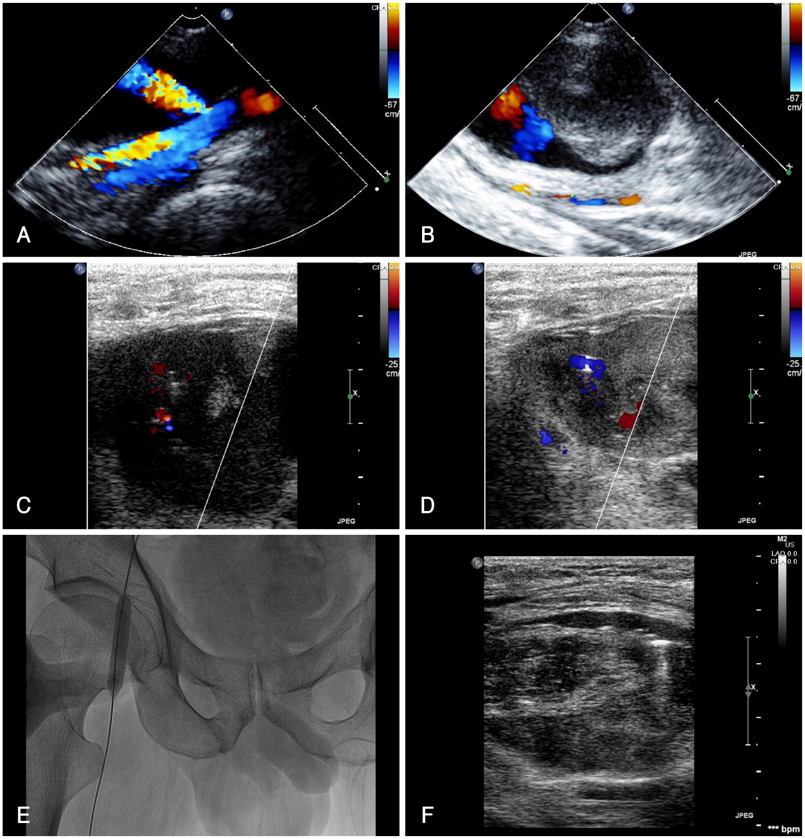Korean Circ J.
2010 Jun;40(6):292-294. 10.4070/kcj.2010.40.6.292.
Successful Treatment of an Iatrogenic Giant Femoral Artery Pseudoaneurysm With Percutaneous Thrombin Injection
- Affiliations
-
- 1Department of Medicine, Dong-Eui University College of Oriental Medicine, Cardiac and Vascular Center, Dong-Eui Medical Center, Busan, Korea. cormed@empas.com
- KMID: 2225191
- DOI: http://doi.org/10.4070/kcj.2010.40.6.292
Abstract
- A femoral artery pseudoaneurysm (FAP) is one of the most troublesome complications following invasive procedures related to the femoral arterial access. Post-procedure FAP rarely occurs; however, its occurrence tends to increase with the more frequently antiplatelet agents, anticoagulants, and larger-sized catheter used for interventional procedures. Traditionally, surgical repair has been considered as the standard treatment modality for FAP; however, less invasive methods currently exist such as blind manual or ultrasound-guided compression repair (UGCR) as well as percutaneous thrombin injection, both of which have replaced the need for surgery. We report a case of a giant pseudoaneurysm in a femoral artery, which had developed as a complication of stenting in a patient with carotid artery stenosis and ischemic heart disease, and was subsequently successfully treated using percutaneous thrombin injection.
Keyword
MeSH Terms
Figure
Reference
-
1. Webber GW, Jang J, Gustavson S, Olin JW. Contemporary management of postcatheterization pseudoaneurysms. Circulation. 2007. 115:2666–2674.2. Ku BK, Kim HS, Ko CW, et al. A case of femoral artery pseudoaneurysm treated with compression guided by color Doppler ultrasound. Korean Circ J. 1995. 25:119–123.3. Lenartova M, Tak T. Iatrogenic pseudoaneurysm of femoral artery: case report and literature review. Clin Med Res. 2003. 1:243–247.4. Popovic B, Freysz L, Chometon F, et al. Femoral pseudoaneurysms and current cardiac catheterization: evaluation of risk factors and treatment. Int J Cardiol. 2008. DOI:10.1016/j.ijcard.2008.11.111.5. San Norberto García EM, González-Fajardo J, Gutiérrez V, Carrera S, Vaquero C. Femoral pseudoaneurysms post-cardiac catheterization surgically treated: evolution and prognosis. Interact Cardiovasc Thorac Surg. 2009. 8:353–357.6. Madaric J, Vulev I, Mistrik A, et al. The recurrence of iatrogenic femoral artery pseudoaneurysm after occlusion by ultrasound guided percutaneous thrombin injection. EuroIntervention. 2009. 5:443–447.7. La Perna L, Olin JW, Goines D, Quriel K. Ultrasound-guided thrombin injection for the treatment of postcatheterization pseudoaneurysms. Circulation. 2000. 102:2391–2395.
- Full Text Links
- Actions
-
Cited
- CITED
-
- Close
- Share
- Similar articles
-
- A Case of Successful Treatment of Huge Pseudoaneurysm Complicated with Endovascular Intervention Using Thrombin Injection
- Effect of Percutaneous Thrombin Injection under Ultrasonography Guidance for Occlusion of Common Femoral Artery Pseudoaneurysm after Failed Ultrasonography-guided Compression: A Case Report
- Percutaneous Thrombin Injection with Balloon Occlusion for the Treatment of a Femoral Artery Pseudoaneurysm
- Balloon-Assisted Ultrasound-Guided Thrombin Injection of a Pseudoaneurysm in the Posterior Tibial Artery: A Case Report
- Clinical Outcomes of Ultrasound-Guided Thrombin Injection for the Treatment of Iatrogenic Pseudoaneurysm


